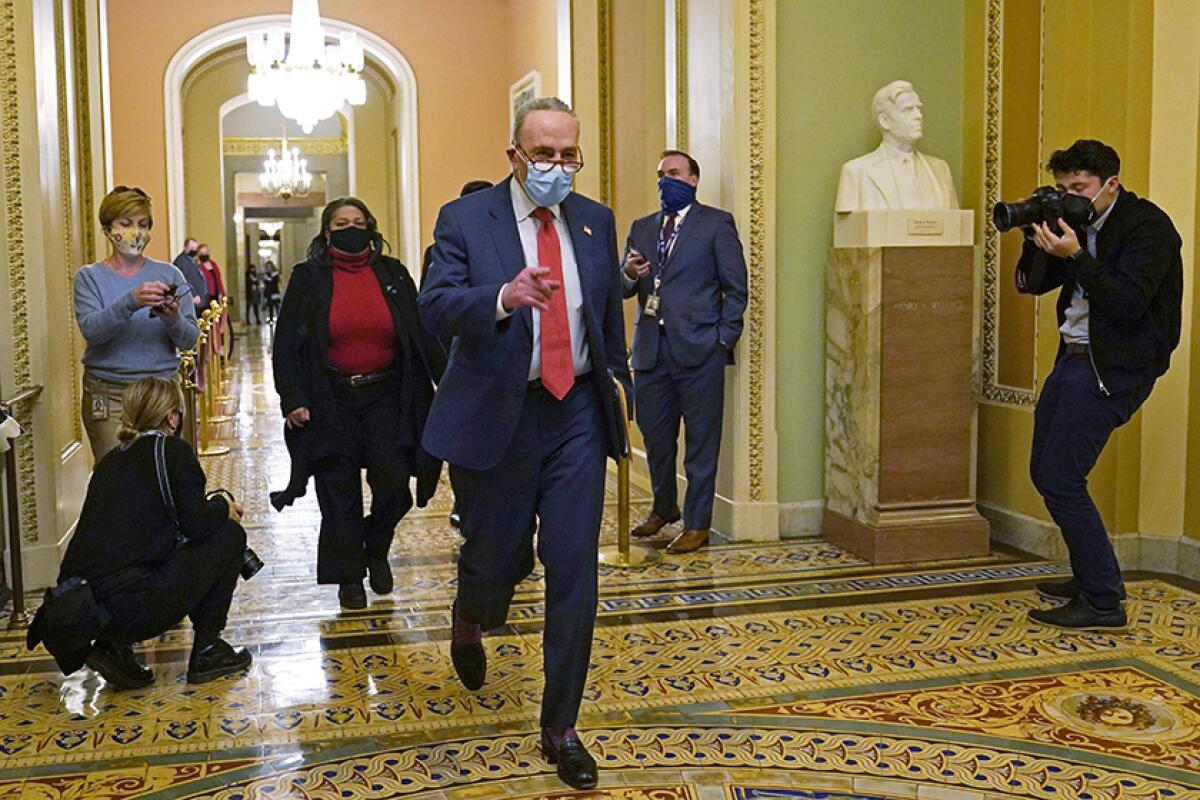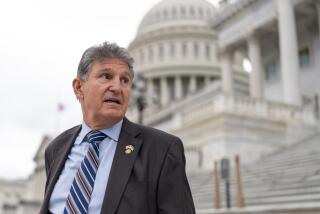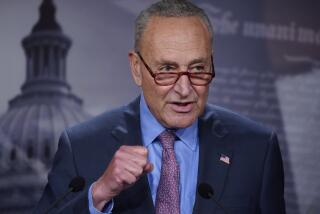Democrats struggle to get infrastructure plan off the ground

WASHINGTON — President Biden and congressional Democrats accomplished their primary checklist during their first 100 days in control of Washington. They enacted a historic pandemic rescue package, shot 200 million COVID-19 vaccines into Americans’ arms and confirmed a Cabinet.
But now the reality of how difficult the next steps of Biden’s presidency will be is crashing down on Democrats.
The infrastructure bill is struggling to get off the ground. Sen. Joe Manchin III (D-W.Va.) is not budging on his refusal to support progressive Democrats’ plan to scrap the filibuster and its 60-vote threshold.
With a 50-50 split Senate, Democrats are just one seat away from returning to minority status; in the House their majority is down to just a few seats.
“We have lots of other things to do,” Senate Majority Leader Charles E. Schumer (D-N.Y.) told reporters at the Capitol on Wednesday ahead of Biden’s speech to Congress. “I would remind you that people were skeptical when we took office — our majority — that we could get three things done at once: the Cabinet, impeachment, the [American Rescue Plan]. … We’re going to do many more things together.”
But Democratic control of the trifecta — the White House, House and Senate — doesn’t mean that any of this will be easy.
Democrats have yet to make finals decisions about how to structure the infrastructure plan and which policies will be included. With Republicans strongly opposed to the tax increases that Biden wants to pay for it, Democrats are likely to have to enact at least some of it through reconciliation, the legislative procedure that allows them to circumvent a Republican filibuster.
But Democrats are conflicted on whether to roll it all into one massive plan or try to enact some of it with Republicans.
They also haven’t made policy decisions. Progressive Democrats are pressing the White House to go bigger and make the most of the Democratic majorities while they have them, particularly on healthcare policy, an issue that won them the House majority in 2018.
The White House blueprint would make permanent an expansion of Affordable Care Act subsidies that Democrats enacted on a short-term basis earlier this year, but it made no other mention of major health policies.
Congressional Democrats are much more eager, already saying that they want a permanent extension of the child tax credit — the White House only plans to do it through 2025 — and to reform the nation’s prescription drug policy, even if it means a huge battle with the pharmaceutical industry.
In recent days, dozens of Democratic lawmakers, including House Speaker Nancy Pelosi (D-San Francisco), have urged the White House to support policy to allow Medicare to negotiate rates with drugmakers, a progressive goal that has eluded House Democrats since they set it as a campaign pledge in 2006.
“A lot of us are trying to reach out to try to reassure the White House that there is very, very solid support,” said Rep. Peter Welch (D-Vt.), a longtime advocate of negotiated rates.
In his address Wednesday night, Biden called for Congress to enact legislation to allow Medicare to negotiate rates this year. But he did not include it in his blueprint, suggesting that he might want it done separately.
Sen. Bernie Sanders (I-Vt.), whose budget committee will be responsible for starting the process of writing an infrastructure bill, insisted that the final product will allow Medicare drug negotiations as well as an expansion of Medicare benefits — such as dental and vision — and lower the age of eligibility below 65.
“If I have anything to say about it, it will,” he said.
But it’s far from certain that’s how a plan would end up. A minority of Democrats, particularly those with deep ties to drugmakers, are reluctant to allow Medicare to negotiate rates. They are even more conflicted about how to use the savings, estimated at about $450 billion over a decade, with some advocating to use it to lower the Medicare age and expand benefits in that program, and others calling for it to be used to expand Affordable Care Act benefits.
Any policy that makes it into the plan will need the support of all Senate Democrats, a potentially Herculean task. Vice President Kamala Harris has been calling Democratic senators for their ideas, according to Sen. Richard J. Durbin (D-Ill.).
In the first 100 days of Biden’s presidency, Democrats were buoyed by their surprise takeover of the Senate and a common mission: delivering a new COVID-19 relief bill. The bill was largely already written and was widely supported by Democrats, greasing the skids and perhaps lulling members and the public into the idea that legislating would be easier than it is.
The hope Democrats once had of eliminating or reforming the filibuster this year has receded. Manchin and Sen. Kyrsten Sinema (D-Ariz.) have made their opposition clear — and a handful of other Democrats are suspected to be more quietly against the idea. Advocates of filibuster reform have notched notable victories — including movement on the issue by formerly hard-line opponents, such as Biden and Sen. Dianne Feinstein (D-Calif.). But Manchin has repeatedly said that he won’t support changing the filibuster, probably dooming the issue unless he changes his mind or Democrats have more votes in the Senate.
The last time the Senate was 50-50, the divide lasted less than five months until then-Sen. Jim Jeffords of Vermont left the Republican Party to become an independent who caucused with Democrats, in effect giving them the majority. While there is little chance of any member changing parties in today’s environment, one Democratic departure — whether because of illness, death or a political scandal — could flip control back into Republican hands.
In the vast majority of the states with Democratic senators, a Democratic governor would choose a replacement or a Republican governor would have to choose a replacement from the same party as the senator.
But in several states where Democrats currently hold a Senate seat, a sudden vacancy over the next 18 months could cost the party its majority before the 2022 election. They include Georgia, Montana, New Hampshire, Ohio and West Virginia, where a Republican governor chooses a replacement until the next regular election; and Massachusetts and Vermont, where a Republican governor chooses an interim replacement until a special election can be held, according to the National Conference of State Legislatures. In Oregon, Rhode Island and Wisconsin, the seat is left vacant until an election is held.
Elected Democrats say there’s no point in dwelling on such a risk. But privately, staff members say it’s on their minds, particularly because of the Supreme Court and the likelihood that Republicans — if they retook the Senate — could repeat their blockade of Merrick Garland’s nomination to the bench during President Obama’s term.
“I really hadn’t thought about it,” said Sen. Jon Tester (D-Mont.) when asked if Democrats worry about the possibility of an illness or a scandal reducing their ranks, “and I could be the one that kicks over tomorrow.”
More to Read
Get the L.A. Times Politics newsletter
Deeply reported insights into legislation, politics and policy from Sacramento, Washington and beyond. In your inbox three times per week.
You may occasionally receive promotional content from the Los Angeles Times.











